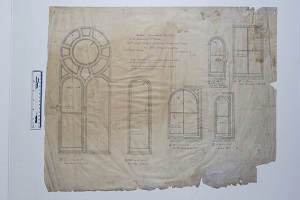
Spend much time on Galveston Island and you’ll likely hear the name Nicholas Clayton – and you’ll certainly see his work. The esteemed architect was the principal designer on the island in the late 19th century and there are examples of his work in homes dotting the historic East End and some of the Island’s iconic buildings: The Bishop’s Palace, St. Patrick’s church and the Ashbel Smith building, home of the first medical school in the state – the University of Texas Medical Branch at Galveston.
On campus and throughout the larger Galveston community, the building is known simply as “Old Red,” for its red pressed brick, red Texas granite and sandstone. Commissioned by the board of regents of the University of Texas, the building opened its door to the first medical class in 1891.
Over the next century, many of Clayton’s buildings were lost but Old Red has survived – the great storm of 1900, Hurricane Ike and a misguided proposal to tear it down for a parking garage in the late 60s.
The first class for incoming medical students is anatomy and, for more than a century, the course was taught on the top floor of Old Red. However, Hurricane Ike wrought extensive damage on campus including Old Red and anatomy has moved to another building, leaving the top floor vacant.
Enter Paula Summerly: history detective. Summerly first arrived at UTMB in August 2012 as a visiting scholar in the Institute for the Medical Humanities. With an undergraduate degree in fine art photography and a doctorate in the history of medicine, her interest and research led to her first exhibit on campus, “Abstract anatomy: The wall diagrams of William Keiller, MD (1861-1931).
Keiller, the first professor of anatomy at UTMB, was also a gifted artist whose drawings are housed in the Truman G. Blocker, Jr. History of Medicine Collections at the Moody Medical Library. In her research for the Keiller exhibit, Summerly delved into the history of Old Red and discovered it had been home to two museums. Now the research project manager for the John P. McGovern Academy of Oslerian Medicine, she also serves as chairperson of the Old Red Medical Museum and Task Force Heritage Committee, which is researching the possibility of reviving the museum on the top floor.
Summerly felt it was important to see Clayton’s original plans and discovered the only surviving architectural drawings were housed in the Galveston and Texas History Center of the Rosenberg Library Museum.
“They had never been photographed, copied or reproduced due to their fragile nature,” said Summerly. After viewing them, “I was immediately struck by their importance to my research as well as their aesthetic quality and fragile condition.” That fragility rendered them virtually inaccessible to scholars, much less the general public. But photographing delicate historic documents requires special care and some expense.
 As a historian, Summerly felt it imperative to preserve these documents. With remarkable dedication and a little serendipity, she connected with several people who, collectively, made this digital dream come true. The first goal was obtaining permission to photograph the drawings.
As a historian, Summerly felt it imperative to preserve these documents. With remarkable dedication and a little serendipity, she connected with several people who, collectively, made this digital dream come true. The first goal was obtaining permission to photograph the drawings.
“The Nicholas Clayton architectural drawings are very important,” said Peggy Dillard, manager of special collections at the Rosenberg Library, “but they are deteriorating, falling apart.” She was delighted with the opportunity to photograph them and the project was generously funded by Dr. Barbara L. Thompson, professor and chairwoman of the department of Family Medicine and Emeritus Scholar, John P. McGovern Academy of Oslerian Medicine.
“Thanks to the generosity of the organization and her perseverance these drawings will be available for future researchers,” said Dillard. She noted Summerly’s only agenda was the preservation of important and historic materials. “That’s what makes her a true scholar.”
Only 17 of Clayton’s drawings for Old Red still exist, including copies of blue prints, window and door frames. But because of Summerly’s efforts, digital copies now are held in the special collections at the Rosenberg Library and the John P. McGovern Academy of Oslerian Medicine at UTMB.